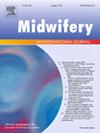Perceptions of birth and wellbeing after birth debriefing among women who describe their birth as traumatic
IF 2.6
3区 医学
Q1 NURSING
引用次数: 0
Abstract
Introduction
In Australia, birth debriefing (BD) practices have primarily focused on clinical PTSD-FC, often neglecting the needs of mothers who describe their birth as traumatic but do not meet PTSD-FC criteria. The cessation of routine BD has overlooked a significant cohort- mothers experiencing subjective birth trauma (SBT). Their perceptions and wellbeing during the postpartum period remain poorly understood, and the lack of targeted interventions limits options for these mothers. This study investigates the wellbeing and birth perceptions of Australian mothers one to three years postpartum, focusing on the impact of BD for both mothers with and without reported birth trauma and exploring alternative reflective interventions.
Method
Using a cross-sectional and correlational design, the study compared mothers with SBT to those without. Participants completed validated assessment tools: Childbirth Perception Scale, Self-Compassion Scale (Short Form), and Childbirth Experience Questionnaire (CEQ). Additional questions explored experiences with BD and other reflective practices.
Results
Of the 273 participants, 33.7 % reported traumatic birth experiences. A substantial proportion (80 %) expressed a desire to discuss their birth experiences, yet only 26 % underwent BD, and 64.4 % were unaware of its specifics. BD notably enhanced perceptions of birth for mothers without reported trauma but showed varied effectiveness for those with reported trauma. Writing interventions also emerged as a potentially beneficial alternative for processing birth experiences. Differences in emotional validation were noted between in-hospital and out-of-hospital debrief settings.
Discussion
Results highlight the need for person-centred, choice-based approaches in postnatal care, particularly for mothers experiencing SBT. While BD shows potential benefits for non-traumatised mothers, its varied effectiveness for those with trauma suggests a need for more tailored, trauma-informed debriefing approaches. Expanding access to diverse interventions that cater to all individuals and understanding BDs role in broader postnatal care could improve maternal outcomes.
出生后对分娩和幸福的看法,对那些认为自己的出生是创伤性的妇女进行述职。
简介:在澳大利亚,出生汇报(BD)的实践主要集中在临床PTSD-FC,往往忽视了母亲的需求,他们描述自己的出生创伤,但不符合PTSD-FC标准。常规双相障碍的停止忽视了一个重要的队列-经历主观分娩创伤(SBT)的母亲。她们在产后期间的看法和健康状况仍然知之甚少,缺乏有针对性的干预措施限制了这些母亲的选择。本研究调查了澳大利亚母亲产后1至3年的幸福感和分娩感知,重点关注双相障碍对有或没有分娩创伤的母亲的影响,并探索其他反思干预措施。方法:采用横断面和相关设计,研究比较了有SBT的母亲和没有SBT的母亲。参与者完成了有效的评估工具:分娩感知量表、自我同情量表(简表)和分娩体验问卷(CEQ)。其他问题探讨了BD和其他反思实践的经验。结果:在273名参与者中,33.7%的人报告了创伤性分娩经历。相当大比例(80%)的人表示希望讨论他们的出生经历,但只有26%的人患有双相障碍,64.4%的人不知道其具体情况。双相障碍显著增强了没有创伤报告的母亲对分娩的感知,但对有创伤报告的母亲表现出不同的效果。写作干预也成为处理分娩经历的潜在有益选择。情绪确认在院内和院外的汇报设置之间存在差异。讨论:结果强调需要以人为本,基于选择的产后护理方法,特别是对经历性行为感染的母亲。虽然双相障碍显示出对未受创伤母亲的潜在益处,但其对那些有创伤的母亲的不同效果表明,需要更有针对性的、了解创伤情况的汇报方法。扩大获得适合所有个体的各种干预措施的机会,并了解bd在更广泛的产后护理中的作用,可以改善孕产妇结局。
本文章由计算机程序翻译,如有差异,请以英文原文为准。
求助全文
约1分钟内获得全文
求助全文
来源期刊

Midwifery
医学-护理
CiteScore
4.50
自引率
7.40%
发文量
221
审稿时长
13.4 weeks
期刊介绍:
Midwifery publishes the latest peer reviewed international research to inform the safety, quality, outcomes and experiences of pregnancy, birth and maternity care for childbearing women, their babies and families. The journal’s publications support midwives and maternity care providers to explore and develop their knowledge, skills and attitudes informed by best available evidence.
Midwifery provides an international, interdisciplinary forum for the publication, dissemination and discussion of advances in evidence, controversies and current research, and promotes continuing education through publication of systematic and other scholarly reviews and updates. Midwifery articles cover the cultural, clinical, psycho-social, sociological, epidemiological, education, managerial, workforce, organizational and technological areas of practice in preconception, maternal and infant care.
The journal welcomes the highest quality scholarly research that employs rigorous methodology. Midwifery is a leading international journal in midwifery and maternal health with a current impact factor of 1.861 (© Thomson Reuters Journal Citation Reports 2016) and employs a double-blind peer review process.
 求助内容:
求助内容: 应助结果提醒方式:
应助结果提醒方式:


